Mitsubishi Outlander: DTC B1B08, B1B09, B1B0A, B1B0B, B1B0C, B1B0D, B1B0E, B1B0F, B1B18, B1B19
DTC B1B08: Passenger's (Front) Air Bag Module (1st squib) System (Shorted
to Squib Circuit
Ground)
DTC B1B0C: Passenger's (Front) Air Bag Module (2nd squib) System (Shorted to
Squib Circuit
Ground)
Passenger's (Front) Air Bag Module (Squib) Circuit

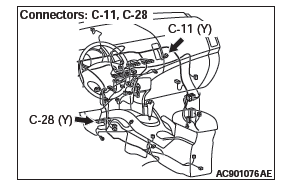
CAUTION
- If DTC B1B08 <1st squib> or B1B0C <2nd squib> is set in the SRS-ECU, always diagnose the CAN main bus line.
- When DTC B1B08 is set in the following diagnosis, check the 1st squib circuit. When DTC B1B0C is set, check the 2nd squib circuit.
CIRCUIT OPERATION
- The SRS-ECU judges how severe a collision is by detecting signals from the front impact sensors and the front air bag analog G-sensor. If the impact is over a predetermined level, the SRS-ECU sends an ignition signal. At this time, if the front air bag safing G-sensor is on, the SRS air bag will inflate.
- The ignition signal is input to the air bag module to inflate the air bag.
DTC SET CONDITIONS
This DTC is set if there is abnormal resistance between the input terminals of the passenger's (front) air bag module (squib).
TROUBLESHOOTING HINTS
- Damaged harness wires and connectors
- Short to the ground in the passenger's (front) air bag module (squib) harness
- Malfunction of the SRS-ECU
DIAGNOSIS
Required Special Tools:
- MB991958: Scan Tool (M.U.T.-III Sub Assembly)
- MB991824: Vehicle Communication Interface (V.C.I.)
- MB991827: M.U.T.-III USB Cable
- MB991910: M.U.T.-III Main Harness A (Vehicles with CAN Communication System)
- MB991865: Dummy resistor
- MB991866: Resister harness
STEP 1. Using scan tool MB991958, diagnose the CAN bus line.
CAUTION To prevent damage to scan tool MB991958, always turn the ignition switch to the "LOCK" (OFF) position before connecting or disconnecting scan tool MB991958.
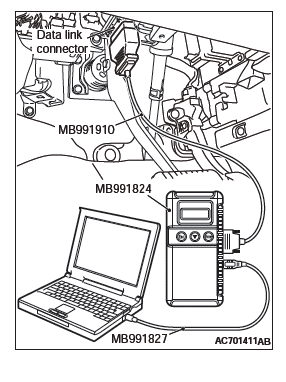
- Connect scan tool MB991958. Refer to "How to connect the scan tool".
- Turn the ignition switch to the "ON" position.
- Diagnose the CAN bus line.
- Turn the ignition switch to the "LOCK" (OFF) position.
Q: Is the CAN bus line found to be normal?
YES : Go to Step 2.
NO : Repair the CAN bus line.
STEP 2. Recheck for diagnostic trouble code.
Check again if the DTC is set.

- Erase the DTC.
- Turn the ignition switch to the "ON" position.
- Check if the DTC is set.
- Turn the ignition switch to the "LOCK" (OFF) position.
Q: Is the DTC set?
YES : Go to Step 3.
NO : There is an intermittent malfunction such as poor engaged connector(s) or open circuit.
STEP 3. Check the passenger's (front) air bag module.
(Using scan tool MB991958, read the diagnostic trouble code.)

- Disconnect the negative battery terminal.
- Disconnect the passenger's (front) air bag module connector C-11.
- Slide the outer housing of passenger's (front) air bag module connector C-11 in the arrow direction shown, and disconnect the connector.

- Connect special tool MB991865 to special tool MB991866.
CAUTION Do not insert a test probe into the terminal from its front side directly, as the connector contact pressure may be weakened.
- Insert special tool MB991866 into the harness side connector C-11 (terminal No.1 and 2 <1st squib> or terminal No.3 and 4 <2nd squib>) by backprobing.
- Connect the negative battery terminal.
CAUTION Always DTC B1B0E is set when checking DTC B1B08. This is because the second side terminal is isolated when checking it. DTC B1B0E is set but this is not a fault. In addition, always DTC B1B0A is set when checking DTC B1B0C because the first side terminal is isolated.
- Erase the diagnostic trouble code memory, and check the diagnostic trouble code.
Q: Is the checked DTC set?
YES : Go to Step 4.
NO : Replace the passenger's (front) air bag module.
STEP 4. Check the passenger's (front) air bag module circuit. Measure the resistance at the SRS-ECU connector C-28.

- Disconnect the negative battery terminal.
- While pushing the part "A" indicated in the figure of the harness side connector, turn the lock lever to the direction of the arrow to release the lock lever, and disconnect the C-28 SRS-ECU connector.

DANGER To prevent the air bag from deploying unintentionally, disconnect the passenger's (front) air bag module connector C-11 to short the squib circuit.
- Slide the outer housing of passenger's (front) air bag module connector C-11 in the arrow direction shown, and disconnect the connector.
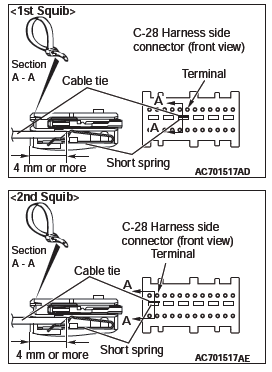
CAUTION Insert an insulator such as a cable tie to a depth of 4 mm (0.16 inch) or more, otherwise the short spring will not be released.
- Insert a cable tie [3 mm (0.12 inch) wide, 0.5 mm (0.02 inch) thick] between terminals 7 and 8 <1st squib> or 11 and 12 <2nd squib>, and the short spring to release the short spring.

- Check for continuity between C-28 harness side connector
terminals 7 and 8 <1st squib> or 11 and 12 <2nd squib>,
and body ground.
It should be an open circuit.
Q: Is it open circuit?
YES : Erase the diagnostic trouble code memory, and check the diagnostic trouble code. If DTC B1B08 <1st squib> B1B0C <2nd squib> sets, replace the SRS-ECU. Go to Step 6.
NO : Go to Step 5.
STEP 5. Check the harness wires for short circuit to ground between the following connector.
- SRS-ECU connector C-28 (terminal No.7 and 8) and passenger's (front) air bag module connector C-11 (terminal No.2 and 1) <1st squib>.
- SRS-ECU connector C-28 (terminal No.11 and 12) and passenger's (front) air bag module connector C-11 (terminal No.4 and 3) <2nd squib>.
Q: Is the check result normal?
YES : Go to Step 6.
NO : Repair the harness wires between SRS-ECU connector C-28 and passenger's (front) air bag module connector C-11. Then go to Step 6.
STEP 6. Recheck for diagnostic trouble code.
Check again if the DTC is set.

- Erase the DTC.
- Turn the ignition switch to the "ON" position.
- Check if the DTC is set.
- Turn the ignition switch to the "LOCK" (OFF) position.
Q: Is DTC B1B08 <1st squib> B1B0C <2nd squib> set?
YES : Return to Step 1.
NO : The procedure is complete.
DTC B1B09: Passenger's (Front) Air Bag Module (<1st squib>) System
(Shorted to Squib Circuit
Power Supply)
DTC B1B0D: Passenger's (Front) Air Bag Module (<2nd squib>) System (Shorted to
Squib Circuit
Power Supply
Passenger's (Front) Air Bag Module (Squib) Circuit


CAUTION
- If DTC B1B09 <1st squib> or B1B0D <2nd squib> is set in the SRS-ECU, always diagnose the CAN main bus line.
- When DTC B1B09 is set in the following diagnosis, check the 1st squib circuit. When DTC B1B0D is set, check the 2nd squib circuit.
CIRCUIT OPERATION
- The SRS-ECU judges how severe a collision is by detecting signals from the front impact sensors and the front air bag analog G-sensor. If the impact is over a predetermined level, the SRS-ECU sends an ignition signal. At this time, if the front air bag safing G-sensor is on, the SRS air bag will inflate.
- The ignition signal is input to the air bag module to inflate the air bag.
DTC SET CONDITIONS
This DTC is set if there is abnormal resistance between the input terminals of the passenger's (front) air bag module (squib).
TROUBLESHOOTING HINTS
- Damaged harness wires and connectors
- Short to the power supply in the passenger's (front) air bag module (squib) harness
- Malfunction of the SRS-ECU
DIAGNOSIS
Required Special Tools:
- MB991958: Scan Tool (M.U.T.-III Sub Assembly)
- MB991824: Vehicle Communication Interface (V.C.I.)
- MB991827: M.U.T.-III USB Cable
- MB991910: M.U.T.-III Main Harness A (Vehicles with CAN Communication System)
- MB991865: Dummy resistor
- MB991866: Resister harness
STEP 1. Using scan tool MB991958, diagnose the CAN bus line.
CAUTION To prevent damage to scan tool MB991958, always turn the ignition switch to the "LOCK" (OFF) position before connecting or disconnecting scan tool MB991958.

- Connect scan tool MB991958. Refer to "How to connect the scan tool".
- Turn the ignition switch to the "ON" position.
- Diagnose the CAN bus line.
- Turn the ignition switch to the "LOCK" (OFF) position.
Q: Is the CAN bus line found to be normal?
YES : Go to Step 2.
NO : Repair the CAN bus line.
STEP 2. Recheck for diagnostic trouble code.
Check again if the DTC is set.
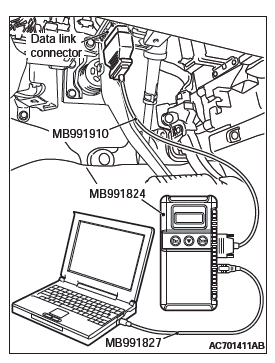
- Erase the DTC.
- Turn the ignition switch to the "ON" position.
- Check if the DTC is set.
- Turn the ignition switch to the "LOCK" (OFF) position.
Q: Is the DTC set?
YES : Go to Step 3.
NO : There is an intermittent malfunction such as poor engaged connector(s) or open circuit.
STEP 3. Check the passenger's (front) air bag module.
(Using scan tool MB991958, read the diagnostic trouble code.)

- Disconnect the negative battery terminal.
- Slide the outer housing of passenger's (front) air bag module connector C-11 in the arrow direction shown, and disconnect the connector.

- Connect special tool MB991865 to special tool MB991866.
CAUTION Do not insert a probe into the terminal from its front side directly, as the connector contact pressure may be weakened.
- Insert special tool MB991866 into the harness side connector C-11 (terminal No.1 and 2 <1st squib> or terminal No.3 and 4 <2nd squib>) by backprobing.
- Connect the negative battery terminal.
CAUTION Always DTC B1B0E is set when checking DTC B1B09. This is because the second side terminal is isolated when checking it. DTC B1B0E is set but this is not a fault. In addition, always DTC B1B0A is set when checking DTC B1B0D because the first side terminal is isolated.
- Erase the diagnostic trouble code memory, and check the diagnostic trouble code.
Q: Is the checked DTC set?
YES : Go to Step 4.
NO : Replace the passenger's (front) air bag module. Then go to Step 6.
STEP 4. Check the passenger's (front) air bag module circuit. Measure the voltage at the SRS-ECU connector C-28.

- Disconnect the negative battery terminal.
- While pushing the part "A" indicated in the figure of the harness side connector, turn the lock lever to the direction of the arrow to release the lock lever, and disconnect the C-28 SRS-ECU connector.
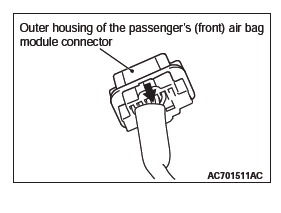
DANGER To prevent the air bag from deploying unintentionally, disconnect the passenger's (front) air bag module connector C-11 to short the squib circuit.
- Disconnect the passenger's (front) air bag module connector C-11.
- Slide the outer housing of passenger's (front) air bag module connector C-11 in the arrow direction shown, and disconnect the connector.

CAUTION Insert an insulator such as a cable tie to a depth of 4 mm (0.16 inch) or more, otherwise the short spring will not be released.
- Insert a cable tie [3 mm (0.12 inch) wide, 0.5 mm (0.02 inch) thick] between terminals 7 and 8 <1st squib> or 11 and 12 <2nd squib>, and the short spring to release the short spring.
- Connect the negative battery terminal.
- Ignition switch: ON.

- Measure the voltage between C-28 harness side connector
terminals 7 and 8 <1st squib> or 11 and 12 <2nd squib>
and body ground.
Voltage should measure 1 volt or less.
Q: Is the measured voltage within the specified range?
YES : Erase the diagnostic trouble code memory, and check the diagnostic trouble code. If DTC B1B09 <1st squib> B1B0D <2nd squib> sets, replace the SRS-ECU. Then go to Step 6.
NO : Go to Step 5.
STEP 5. Check the harness wires for short circuit to power supply between the following connector.
- SRS-ECU connector C-28 (terminal No.7 and 8) and passenger's (front) air bag module connector C-11 (terminal No.2 and 1) <1st squib>.
- SRS-ECU connector C-28 (terminal No.11 and 12) and passenger's (front) air bag module connector C-11 (terminal No.4 and 3) <2nd squib>.
Q: Is the check result normal?
YES : Go to Step 6.
NO : Repair the harness wires between SRS-ECU connector C-28 and passenger's (front) air bag module connector C-11. Then go to Step 6.
STEP 6. Recheck for diagnostic trouble code.
Check again if the DTC is set.
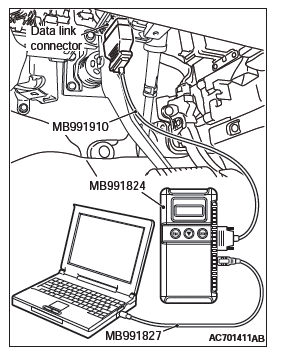
- Erase the DTC.
- Turn the ignition switch to the "ON" position.
- Check if the DTC is set.
- Turn the ignition switch to the "LOCK" (OFF) position.
Q: Is DTC B1B09 <1st squib> B1B0D <2nd squib> set?
YES : Return to Step 1.
NO : The procedure is complete.
DTC B1B0A: Passenger's (Front) Air Bag Module (1st squib) System (Squib
Circuit Open)
DTC B1B0E: Passenger's (Front) Air Bag Module (2nd squib) System (Squib Circuit
Open)
Passenger's (Front) Air Bag Module (Squib) Circuit
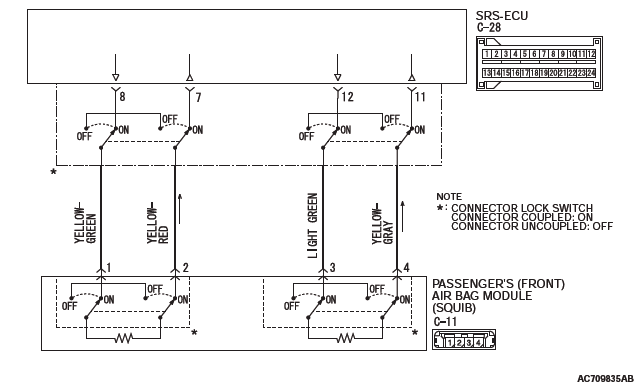

CAUTION
- If DTC B1B0A <1st squib> or B1B0E <2nd squib> is set in the SRS-ECU, always diagnose the CAN main bus line.
- When DTC B1B0A is set in the following diagnosis, check the 1st squib circuit. When DTC B1B0E is set, check the 2nd squib circuit.
CIRCUIT OPERATION
- The SRS-ECU judges how severe a collision is by detecting signals from the front impact sensors and the front air bag analog G-sensor. If the impact is over a predetermined level, the SRS-ECU sends an ignition signal. At this time, if the front air bag safing G-sensor is on, the SRS air bag will inflate.
- The ignition signal is input to the air bag module to inflate the air bag.
DTC SET CONDITIONS
This DTC is set if there is abnormal resistance between the input terminals of the passenger's (front) air bag module (squib).
TROUBLESHOOTING HINTS
- Open circuit in the passenger's (front) air bag module (squib) circuit
- Improper connector contact
- Malfunction of the SRS-ECU
DIAGNOSIS
Required Special Tools:
- MB991958: Scan Tool (M.U.T.-III Sub Assembly)
- MB991824: Vehicle Communication Interface (V.C.I.)
- MB991817: M.U.T.-III USB Cable
- MB991910: M.U.T.-III Main Harness A (Vehicles with CAN Communication System)
- MB991865: Dummy resister
- MB991866: Resister harness
STEP 1. Using scan tool MB991958, diagnose the CAN bus line.
CAUTION To prevent damage to scan tool MB991958, always turn the ignition switch to the "LOCK" (OFF) position before connecting or disconnecting scan tool MB991958.

- Connect scan tool MB991958. Refer to "How to connect the scan tool".
- Turn the ignition switch to the "ON" position.
- Diagnose the CAN bus line.
- Turn the ignition switch to the "LOCK" (OFF) position.
Q: Is the CAN bus line found to be normal?
YES : Go to Step 2.
NO : Repair the CAN bus line.
STEP 2. Recheck for diagnostic trouble code.
Check again if the DTC is set.

- Erase the DTC.
- Turn the ignition switch to the "ON" position.
- Check if the DTC is set.
- Turn the ignition switch to the "LOCK" (OFF) position.
Q: Is the DTC set?
YES : Go to Step 3.
NO : There is an intermittent malfunction such as poor engaged connector(s) or open circuit (Refer to GROUP 00, How to Cope with Intermittent Malfunction).
STEP 3. Check the passenger's (front) air bag module.
(Using scan tool MB991958, read the diagnostic trouble code.)

- Disconnect the negative battery terminal.
- Slide the outer housing of passenger's (front) air bag module connector C-11 in the arrow direction shown, and disconnect the connector.

- Connect special tool MB991865 to special tool MB991866.
CAUTION Do not insert a probe into the terminal from its front side directly, as the connector contact pressure may be weakened.
- Insert special tool MB991866 into the harness side connector C-11 (terminal No.1 and 2 <1st squib> or terminal No.3 and 4 <2nd squib>) by backprobing.
- Connect the negative battery terminal.
CAUTION Always DTC B1B0E is set when checking DTC B1B0A. This is because the second side terminal is isolated when checking it. DTC B1B0E is set but this is not a fault. In addition, always DTC B1B0A is set when checking DTC B1B0E because the first side terminal is isolated.
- Erase the diagnostic trouble code memory, and check the diagnostic trouble code.
Q: Is the checked DTC set?
YES : Go to Step 4.
NO : Replace the passenger's (front) air bag module. Then go to Step 5.
STEP 4. Check the harness for open circuit between SRS-ECU connector C-28 and the passenger's (front) air bag module connector C-11.
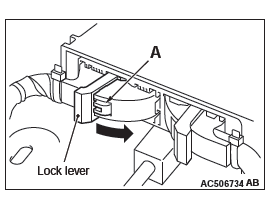
- Disconnect the negative battery terminal.
- While pushing the part "A" indicated in the figure of the harness side connector, turn the lock lever to the direction of the arrow to release the lock lever, and disconnect the C-28 SRS-ECU connector.

DANGER To prevent the air bag from deploying unintentionally, disconnect the passenger's (front) air bag module connector C-11 to short the squib circuit.
- Slide the outer housing of passenger's (front) air bag module connector C-11 in the arrow direction shown, and disconnect the connector.

CAUTION Insert an insulator such as a cable tie to a depth of 4 mm (0.16 inch) or more, otherwise the short spring will not be released.
- Insert a cable tie [3 mm (0.12 inch) wide, 0.5 mm (0.02 inch) thick] between terminals 7 and 8 <1st squib> or 11 and 12 <2nd squib>, and the short spring to release the short spring.

CAUTION Do not insert a probe into the terminal from C-11 harness side connector front side directly as the connector contact pressure may be weakened.
- Check for continuity between the following terminals. It should be less than 2 ohms.
<1st squib>
- SRS-ECU connector C-28 (terminal No.7) and the passenger's (front) air bag module connector C-11 (terminal No.2)
- SRS-ECU connector C-28 (terminal No.8) and the passenger's (front) air bag module connector C-11 (terminal No.1)
<2nd squib>
- SRS-ECU connector C-28 (terminal No.11) and the passenger's (front) air bag module connector C-11 (terminal No.4)
- SRS-ECU connector C-28 (terminal No.12) and the passenger's (front) air bag module connector C-11 (terminal No.3)
Q: Does continuity exist?
YES : Erase the diagnostic trouble code memory, and check the diagnostic trouble code. If DTC B1B0A <1st squib> or B1B0E <2nd squib> set, replace the SRS-ECU. Then go to Step 5.
NO : Repair the harness wires between SRS-ECU connector C-28 and passenger's (front) air bag module connector C-11. Then go to Step 5.
STEP 5. Recheck for diagnostic trouble code.
Check again if the DTC is set.

- Erase the DTC.
- Turn the ignition switch to the "ON" position.
- Check if the DTC is set.
- Turn the ignition switch to the "LOCK" (OFF) position.
Q: Is DTC B1B0A <1st squib> or B1B0E <2nd squib> set?
YES : Return to Step 1.
NO : The procedure is complete.
DTC B1B0B: Passenger's (Front) Air Bag Module (1st squib) System (Short
Circuit Between Squib
Circuit Terminals)
DTC B1B0F: Passenger's (Front) Air Bag Module (2nd squib) System (Short Circuit
Between Squib
Circuit Terminals)
Passenger's (Front) Air Bag Module (Squib) Circuit


CAUTION
- If DTC B1B0B <1st squib> or B1B0F <2nd squib> is set in the SRS-ECU, always diagnose the CAN main bus line.
- When DTC B1B0B is set in the following diagnosis, check the 1st squib circuit. When DTC B1B0F is set, check the 2nd squib circuit.
CIRCUIT OPERATION
- The SRS-ECU judges how severe a collision is by detecting signals from the front impact sensors and the front air bag analog G-sensor. If the impact is over a predetermined level, the SRS-ECU sends an ignition signal. At this time, if the front air bag safing G-sensor is on, the SRS air bag will inflate.
- The ignition signal is input to the air bag module to inflate the air bag.
DTC SET CONDITIONS
This DTC is set if there is abnormal resistance between the input terminals of the passenger's side air bag module (squib).
TROUBLESHOOTING HINTS
- Improper engaged connector or defective short spring*
- Short circuit between the passenger's air bag module (squib) circuit terminals
- Damaged connector(s)
- Malfunction of the SRS-ECU
NOTE: *: The squib circuit connectors integrate a "short" spring (which prevents the air bag from deploying unintentionally due to static electricity by shorting the positive wire to the ground wire in the squib circuit when the connectors are disconnected).
Therefore, if connector C-11 or C-28 is damaged or improperly engaged, the short spring may not be released when the connector is connected.
DIAGNOSIS
Required Special Tools:
- MB991958: Scan Tool (M.U.T.-III Sub Assembly)
- MB991824: Vehicle Communication Interface (V.C.I.)
- MB991827: M.U.T.-III USB Cable
- MB991910: M.U.T.-III Main Harness A (Vehicles with CAN Communication System)
- MB991865: Dummy resister
- MB991866: Resister harness
STEP 1. Using scan tool MB991958, diagnose the CAN bus line.
CAUTION To prevent damage to scan tool MB991958, always turn the ignition switch to the "LOCK" (OFF) position before connecting or disconnecting scan tool MB991958.

- Connect scan tool MB991958. Refer to "How to connect the scan tool".
- Turn the ignition switch to the "ON" position.
- Diagnose the CAN bus line.
- Turn the ignition switch to the "LOCK" (OFF) position.
Q: Is the CAN bus line found to be normal?
YES : Go to Step 2.
NO : Repair the CAN bus line.
STEP 2. Recheck for diagnostic trouble code.
Check again if the DTC is set.

- Erase the DTC.
- Turn the ignition switch to the "ON" position.
- Check if the DTC is set.
- Turn the ignition switch to the "LOCK" (OFF) position.
Q: Is the DTC set?
YES : Go to Step 3.
NO : There is an intermittent malfunction such as poor engaged connector(s) or open circuit (Refer to GROUP 00, How to Cope with Intermittent Malfunction).
STEP 3. Check SRS-ECU connector C-28 and passenger's (front) air bag module connector C-11. (Using scan tool MB991958, read the diagnostic trouble code.)

- Disconnect the negative battery terminal.
- Disconnect connectors C-28 and C-11, and then reconnect them.
- While pushing the part "A" indicated in the figure of the harness side connector, turn the lock lever to the direction of the arrow to release the lock lever, and disconnect the C-28 SRS-ECU connector.
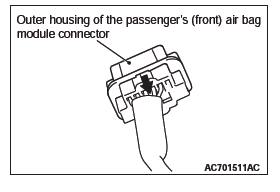
- Slide the outer housing of passenger's (front) air bag module connector C-11 in the arrow direction shown, and disconnect the connector.
- Connect the negative battery terminal.
- Erase the diagnostic trouble code memory, and check the diagnostic trouble code.
Q: Is DTC B1B0B <1st squib> or B1B0F <2nd squib> set?
YES : Go to Step 4.
NO : The procedure is complete. It is assumed that DTC B1B0B <1st squib> or B1B0F <2nd squib> set as connector C-28 or C-11 was engaged improperly.
STEP 4. Check the passenger's (front) air bag module.
(Using scan tool MB991958, read the diagnostic trouble code.)
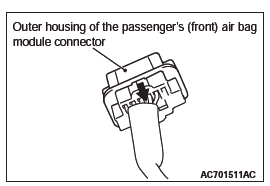
- Disconnect the negative battery terminal.
- Slide the outer housing of passenger's (front) air bag module connector C-11 in the arrow direction shown, and disconnect the connector.
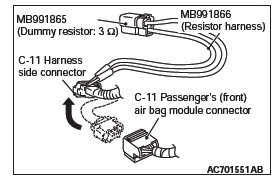
- Connect special tool MB991865 to special tool MB991866.
CAUTION Do not insert a probe into the terminal from its front side directly as the connector contact pressure may be weakened.
- Insert special tool MB991866 into the harness side connector C-11 (terminal No.1 and 2 <1st squib> or terminal No.3 and 4 <2nd squib>) by backprobing.
- Connect the negative battery terminal.
CAUTION Always DTC B1B0E is set when checking DTC B1B0B. This is because the second side terminal is isolated when checking it. DTC B1B0E is set but this is not a fault. In addition, always DTC B1B0A is set when checking DTC B1B0F because the first side terminal is isolated.
- Erase the diagnostic trouble code memory, and check the diagnostic trouble code.
Q: Is the checked DTC set?
YES : Go to Step 5.
NO : Replace the passenger's air bag module. Then go to Step 7.
STEP 5. Check the passenger's (front) air bag module circuit at SRS-ECU connector C-28.

- Disconnect the negative battery terminal.
- While pushing the part "A" indicated in the figure of the harness side connector, turn the lock lever to the direction of the arrow to release the lock lever, and disconnect the C-28 SRS-ECU connector.

DANGER To prevent the air bag from deploying unintentionally, disconnect the passenger's (front) air bag module connector C-11 to short the squib circuit.
- Slide the outer housing of passenger's (front) air bag module connector C-11 in the arrow direction shown, and disconnect the connector.

CAUTION Insert an insulator such as a cable tie to a depth of 4 mm (0.16 inch) or more, otherwise the short spring will not be released.
- Insert a cable tie [3 mm (0.12 inch) wide, 0.5 mm (0.02 inch) thick] between terminals 7 and 8 <1st squib> or 11 and 12 <2nd squib>, and the short spring to release the short spring.

- Check for continuity between C-28 harness side connector
terminals 7 and 8 <1st squib> or 11 and 12 <2nd squib>.
It should be open circuit.
Q: Is it open circuit?
YES : Erase the diagnostic trouble code memory, and check the diagnostic trouble code. If DTC B1B0B <1st squib> or B1B0F <2nd squib> set, replace the SRS-ECU. Go to Step 7.
NO : Go to Step 6.
STEP 6. Check the harness for short circuit between the harness wire and wire.
- SRS-ECU connector C-28 (terminal No.7 and 8) and passenger's (front) air bag module connector C-11 (terminal No.2 and 1) <1st squib>.
- SRS-ECU connector C-28 (terminal No.11 and 12) and passenger's (front) air bag module connector C-11 (terminal No.4 and 3) <2nd squib>.
Q: Is the check result normal?
YES : Go to Step 7.
NO : Repair the harness wires between SRS-ECU connector C-28 and passenger's (front) air bag module connector C-11. Then go to Step 7.
STEP 7. Check for diagnostic trouble code.
Check again if the DTC is set.

- Erase the DTC.
- Turn the ignition switch to the "ON" position.
- Check if the DTC is set.
- Turn the ignition switch to the "LOCK" (OFF) position.
Q: Is DTC B1B0B <1st squib> or B1B0F <2nd squib> set?
YES : Return to Step 1.
NO : The procedure is complete.
DTC B1B18: Curtain Air Bag Module (LH) (Squib) System (Shorted to Squib Circuit Ground)
Curtain Air Bag Module (Squib) (LH) Circuit


CAUTION If DTC B1B18 is set in the SRS-ECU, always diagnose the CAN main bus line.
CIRCUIT OPERATION
- The SRS-ECU judges how severe a collision is by detecting signals from the side impact sensors installed on the lower side of the center pillar and at the quarter panel inner. If the impact is over a predetermined level, the SRS-ECU sends an ignition signal. At this time, if the side collision safing G-sensor is on, the SRS air bag will inflate.
- The ignition signal is input to the curtain air bag module (LH) to inflate the curtain air bag.
DTC SET CONDITIONS
This DTC is set if there is abnormal resistance between the input terminals of the curtain air bag module (LH) (squib).
TROUBLESHOOTING HITS
- Damaged wiring harnesses or connectors
- Short to the ground in the curtain air bag module (LH) (squib) harness
- Malfunction of the SRS-ECU
DIAGNOSIS
Required Special Tools:
- MB991958: Scan Tool (M.U.T.-III Sub Assembly)
- MB991824: Vehicle Communication Interface (V.C.I.)
- MB991827: M.U.T.-III USB Cable
- MB991910: M.U.T.-III Main Harness A (Vehicles with CAN Communication System)
- MB991865: Dummy resistor
- MB991866: Resister harness
STEP 1. Using scan tool MB991958, diagnose the CAN bus line.
CAUTION To prevent damage to scan tool MB991958, always turn the ignition switch to the "LOCK" (OFF) position before connecting or disconnecting scan tool MB991958.

- Connect scan tool MB991958. Refer to "How to connect the scan tool".
- Turn the ignition switch to the "ON" position.
- Diagnose the CAN bus line.
- Turn the ignition switch to the "LOCK" (OFF) position.
Q: Is the CAN bus line found to be normal?
YES : Go to Step 2.
NO : Repair the CAN bus line.
STEP 2. Recheck for diagnostic trouble code.
Check again if the DTC is set.
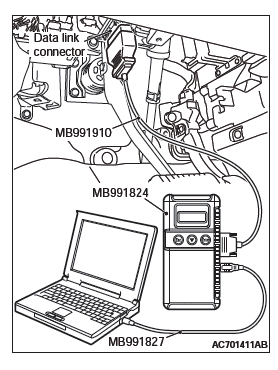
- Erase the DTC.
- Turn the ignition switch to "ON" position.
- Check if the DTC is set.
- Turn the ignition switch to the "LOCK" (OFF) position.
Q: Is the DTC set?
YES : Go to Step 3.
NO : There is an intermittent malfunction such as poor engaged connector(s) or open circuit (Refer to GROUP 00, How to Use Troubleshooting/Inspection Service Points − How to Cope with Intermittent Malfunctions).
STEP 3. Check by dummy resistor connection. (Using scan tool MB991958, read the diagnostic trouble code.)

- Disconnect the negative battery terminal.
- Disconnect the D-13 intermediate connector, unlock the connector by sliding the locking button to the direction of the arrow as shown in the figure, and then disconnect the connector.

- Connect special tool MB991865 to special tool MB991866.
CAUTION Do not insert a probe into the terminal from its front side directly, as the connector contact pressure may be weakened.
- Insert the probe of resistor harness, to which the dummy resistor is installed, from the back of D-13 intermediate connector (floor harness side).
- Connect the negative battery terminal.
- After erasing the diagnostic trouble code memory, check the diagnostic trouble code again.
- Disconnect the negative battery terminal.
Q: Is DTC B1B18 set?
YES : Go to Step 4.
NO : Go to Step 5.
STEP 4. Resistance measurement at the C-27 SRS-ECU connector.

- Disconnect the negative battery terminal.
- While pushing the part "A" indicated in the figure of the harness side connector, turn the lock lever to the direction of the arrow to release the lock lever, and disconnect the C-27 SRS-ECU connector.

DANGER To prevent the air bag from deploying unintentionally, disconnect the intermediate connector D-13 to short the squib circuit.
- Disconnect the D-13 intermediate connector, unlock the connector by sliding the locking button to the direction of the arrow as shown in the figure, and then disconnect the connector.
CAUTION The short spring may not be released due to the insufficient insertion. Therefore, insert the insulator for 4 mm (0.6 inch) or more.
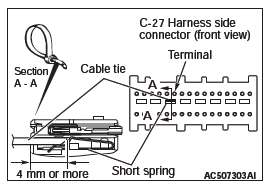
- Insert a cable tie [3 mm (0.12 inch) wide, 0.5 mm (0.02 inch) thick] between terminal 41, 42 and the short spring to release the short spring.

- Check for continuity between C-27 wiring harness side
connector terminal No. 41, 42 and body ground.
It should be open circuit.
Q: Is it open circuit?
YES : Go to Step 6.
NO : Repair the wiring harness.
STEP 5. Resistance measurement at the D-13 intermediate connector.

- Disconnect the negative battery terminal.
DANGER To prevent the air bag from deploying unintentionally, disconnect the curtain air bag module connector D-109 to short the squib circuit.
- Disconnect curtain air bag module (LH) D-109. Use a flat-tipped screwdriver to unlock the locking button at the harness side connector by withdrawing it toward you in two stages, and then disconnect the connector.

- Disconnect the D-13 intermediate connector, unlock the connector by sliding the locking button to the direction of the arrow as shown in the figure, and then disconnect the connector.

- Because the short spring is installed to the D-13 intermediate connector (curtain air bag harness side), insert a cable tie [3 mm (0.12 inch) wide, 0.5 mm (0.02 inch) thick] between terminals 1, 2 and the short spring to release the short spring.

CAUTION Do not insert a probe into the terminal from its front side directly as the connector contact pressure may be weakened.
- Check for continuity between the D-13 intermediate
connector (module side) terminal No. 1, 2 and the body
ground.
It should be open circuit.
Q: Is it open circuit?
YES : Replace the curtain air bag module (squib).
NO : Repair the wiring harness.
STEP 6. Recheck for diagnostic trouble code.
Check again if the DTC is set.

- Erase the DTC.
- Turn the ignition switch to the "ON" position.
- Check if the DTC is set.
- Turn the ignition switch to the "LOCK" (OFF) position.
Q: Is DTC B1B18 set?
YES : Replace SRS-ECU. NO : Intermittent Malfunction (Refer to GROUP 00, How to Use Troubleshooting/Inspection Service Points − How to Cope with Intermittent Malfunction).
DTC B1B19: Curtain Air bag Module (LH) (Squib) System (Shorted to Squib Circuit Power Supply)
Curtain Air Bag Module (Squib) (LH) Circuit


CAUTION If DTC B1B19 is set in the SRS-ECU, always diagnose the CAN main bus line.
CIRCUIT OPERATION
- The SRS-ECU judges how severe a collision is by detecting signals from the side impact sensors installed on the lower side of the center pillar and at the quarter panel inner. If the impact is over a predetermined level, the SRS-ECU sends an ignition signal. At this time, if the side collision safing G-sensor is on, the SRS air bag will inflate.
- The ignition signal is input to the curtain air bag module (LH) to inflate the curtain air bag.
DTC SET CONDITIONS
This DTC is set if there is abnormal resistance between the input terminals of the curtain air bag module (LH) (squib).
TROUBLESHOOTING HITS
- Damaged wiring harnesses or connectors
- Short to the power supply in the curtain air bag module (LH) (squib) harness
- Malfunction of the SRS-ECU
DIAGNOSIS
Required Special Tools:
- MB991958: Scan Tool (M.U.T.-III Sub Assembly)
- MB991824: Vehicle Communication Interface (V.C.I.)
- MB991827: M.U.T.-III USB Cable
- MB991910: M.U.T.-III Main Harness A (Vehicles with CAN Communication System)
- MB991865: Dummy resistor
- MB991866: Resister harness
STEP 1. Using scan tool MB991958, diagnose the CAN bus line.
CAUTION To prevent damage to scan tool MB991958, always turn the ignition switch to the "LOCK" (OFF) position before connecting or disconnecting scan tool MB991958.

- Connect scan tool MB991958. Refer to "How to connect the scan tool".
- Turn the ignition switch to the "ON" position.
- Diagnose the CAN bus line.
- Turn the ignition switch to the "LOCK" (OFF) position.
Q: Is the CAN bus line found to be normal?
YES : Go to Step 2.
NO : Repair the CAN bus line.
STEP 2. Recheck for diagnostic trouble code.
Check again if the DTC is set.

- Erase the DTC.
- Turn the ignition switch to "ON" position.
- Check if the DTC is set.
- Turn the ignition switch to the "LOCK" (OFF) position.
Q: Is the DTC set?
YES : Go to Step 3.
NO : There is an intermittent malfunction such as poor engaged connector(s) or open circuit (Refer to GROUP 00, How to Use Troubleshooting/Inspection Service Points − How to Cope with Intermittent Malfunctions).
STEP 3. Check by dummy resistor connection. (Using scan tool MB991958, read the diagnostic trouble code.)

- Disconnect the negative battery terminal.
- Disconnect the D-13 intermediate connector, unlock the connector by sliding the locking button to the direction of the arrow as shown in the figure, and then disconnect the connector.
- Connect special tool MB991865 to special tool MB991866.

CAUTION Do not insert a probe into the terminal from its front side directly, as the connector contact pressure may be weakened.
- Insert the probe of resistor harness, to which the dummy resistor is installed, from the back of D-13 intermediate connector (floor harness side).
- Connect the negative battery terminal.
- After erasing the diagnostic trouble code memory, check the diagnostic trouble code again.
- Disconnect the negative battery terminal.
Q: Is DTC B1B19 set?
YES : Go to Step 4.
NO : Go to Step 5.
STEP 4. Voltage measurement at the C-27 SRS-ECU connector.

- Disconnect the negative battery terminal.
- While pushing the part "A" indicated in the figure of the harness side connector, turn the lock lever to the direction of the arrow to release the lock lever, and disconnect the C-27 SRS-ECU connector.

DANGER To prevent the air bag from deploying unintentionally, disconnect the intermediate connector D-13 to short the squib circuit.
- Disconnect the D-13 intermediate connector, unlock the connector by sliding the locking button to the direction of the arrow as shown in the figure, and then disconnect the connector.
CAUTION The short spring may not be released due to the insufficient insertion. Therefore, insert the insulator for 4 mm (0.6 inch) or more.

- Insert a cable tie [3 mm (0.12 inch) wide, 0.5 mm (0.02 inch) thick] between terminal 41, 42 and the short spring to release the short spring.
- Connect the negative battery terminal.
- Ignition switch: ON

- Measure the voltage between the C-27 wiring harness side
connector terminal No. 41, 42 and body ground.
Voltage should measure 1 volt or less.
Q: Is the measured voltage within the specified range?
YES : Go to Step 6.
NO : Repair the wiring harness.
STEP 5. Voltage measurement at the D-13 intermediate connector.

- Disconnect the negative battery terminal.
DANGER To prevent the air bag from deploying unintentionally, disconnect the curtain air bag module connector D-109 to short the squib circuit.
- Disconnect curtain air bag module (LH) D-109. Use a flat-tipped screwdriver to unlock the locking button at the harness side connector by withdrawing it toward you in two stages, and then disconnect the connector.

- Disconnect the D-13 intermediate connector, unlock the connector by sliding the locking button to the direction of the arrow as shown in the figure, and then disconnect the connector.

- Because the short spring is installed to the D-13 intermediate connector (curtain air bag harness side), insert a cable tie [3 mm (0.12 inch) wide, 0.5 mm (0.02 inch) thick] between terminals 1, 2 and the short spring to release the short spring.
- Connect the negative battery terminal.
- Ignition switch: ON
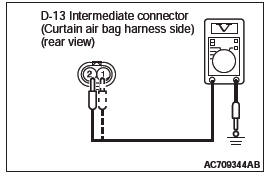
CAUTION Do not insert a probe into the terminal from its front side directly, as the connector contact pressure may be weakened.
- Check for continuity between the D-13 intermediate
connector (curtain air bag harness side) terminal No. 1, 2
and the body ground.
Voltage should measure 1 volt or less.
Q: Is the measured voltage within the specified range?
YES : Replace the curtain air bag module (squib).
NO : Repair the wiring harness.
STEP 6. Recheck for diagnostic trouble code.
Check again if the DTC is set.

- Erase the DTC.
- Turn the ignition switch to the "ON" position.
- Check if the DTC is set.
- Turn the ignition switch to the "LOCK" (OFF) position.
Q: Is DTC B1B19 set?
YES : Replace SRS-ECU.
NO : Intermittent Malfunction.

